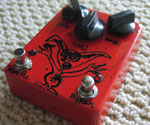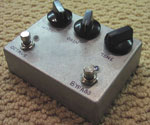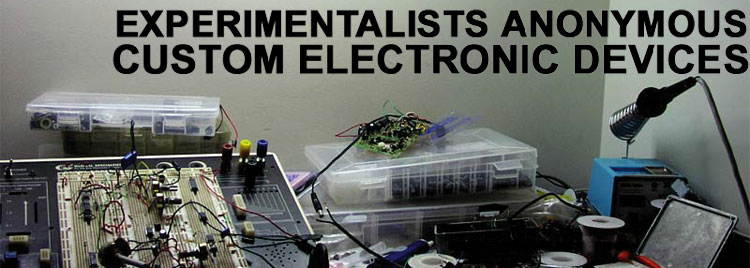
|
Synth in a Month
In January 2006, I built an analog modular synthesizer from the ground up from designs by Ray Wilson. It includes four oscillators, two amplifiers, two filters, two ADSRs, and two mixers. Sounds like brilliant sci-fi bliss :) I careful documented the whole process and summed it all up here. |

|
The Starblaster
In early 2005, I spent a couple of months at the Totnes School of Guitar Making building my dream guitar. I've always liked the way that Fender Coronados and Starcasters looked, so I wanted to mix the two designs and add some features of my own. Over the course of three months, I took pieces of tonewood and carefully shaped them, primarily with handtools, into this guitar. It was a lot of careful and hard work, but it's a brilliant guitar. While in England, I took pictures just about every day of my progress and documented it as a photojournal, you can still view it here. View more pics of the guitar here.
|

|
The Mutant Box
One of my friends asked me to make them a pedal for heavy metal with a mutant theme, and this was the result. I didn't really know what to make as far as heavy metal pedals go, as I had never done so. The end result is a pretty high-gain, mid scooped distortion, with a twist: the mutate switch. The mutate switch just makes it go into oscillating fuzz territory. All sorts of strange tones happen, depending on the position of the gain and tone knobs (the volume knob still functions as only a volume knob, which is great... crazy oscillation at any volume). In the end, I made a box suited for metal but with something a bit towards my flavor of effects pedals. Hopefully metal guitarists enjoy special effects! I wish I had a soundclip. The box is an example of w hat the handpainting I have done can look like.
|

|
Random Rhythm #1 (Concertmate)
This was one of my first circuit bends-it makes all sorts of glitched rhythms and noises via a single momentary switch. It's since died, but I've bought a replacement to bend. Here is a bunch of bent melodies together.
|


|
Random Rhythm #2 & 3 (Casio/No-name)
In the ashes of the first random rhythm, I built these two. They are sort of brother keyboards, because I bent them and finished them at about the same time. I decided to go all out with the paintjob on these. #2 is a very very similar keyboard to #1, just packaged a bit differently. I did the same sort of mods on this one, but was careful to make them a bit more stable, and added a couple more. The patchbay patches some random glitches on the main PCM IC. I added an output jack and volume control, as well as a tone generation switch/knob/photocell, and another switch that makes it rumble in a strange way. The final knob is a glitch knob! It's interesting to dial in more glitchiness. Click here for a soundclip. The third random rhythm is a no-name keyboard I was given by my aunt... this one is very very poorly made, but there was more room inside for switches and all, which was nice. The switch on the far end turns it on and slows it down if you want, while the other switches turn various glitches on and off. The knob is a clock speed control for mega low-pitch low-fi glitchiness.
|

|
Modified Sirkut Electronics Rmod
I added a couple of features to this sirkut electronics Rmod to make it a bit more useful for guitar. Sirkut Electronics has an interesting idea: a fuzzy ring modulator with definite carrier feedthrough-certainly a noisebox. It does its job very well and manages to do so with simple circuitry, but for guitar, a few things were left out: A stompswitch, an LED, a volume knob, and an expression pedal. I added all three to the box, and built an expression pedal to suit.
|

|
The ANTI-Parallel Universe
Here's something a little different-the antiparallel universe. I was asked to build a Parallel universe with a few modifications: More gain and no tone knob. Instead of adding to the circuit, I changed the amplifier chip that's at the heart of the PU to one with slightly more gain. The added gain changes a few things about the PU: In "normal" mode, it's more of a fuzzbox, in "starve" mode, there's less gating, and in "osc" mode, there's more control over whether or not it's oscillating. In the end we have a slightly less tame/stable version of the PU. To hear what the antiparallel universe sounds like with guitar, click here. To hear what it sounds like with a drum machine, click here.
|

|
Modded small stone
This is a modified small clone I did, to make it a bit more useful. It was TBed, the power jack was changed, and a switch was added to make the LFO go super slow... the LED color was also changed and there is a new knob. Though the mods here aren't to heavy, I would be happy to do any sort of mods to a small stone... I have been wanting for a long time to really dig into one of these and give it a manual sweep knob, multiple LFO depth ranges and waveform controls, maybe a step sequencer, feedback controls and switches to change the sound of each stage, etc... so if you have the urge to have a super tweaked out small stone, let me know.
|

|
French Toast Machine
"It sounds fantastic, very cool not to have to worry about reliablity anymore, overall awesome craftsmanship man, very well done." - Joey D
The Danelectro French Toast is essentially identical to the FOXX tone machine, aside from the fact that it is housed in a much cheaper enclosure. Joey really liked the sound of his french toast, but was concerned about the reliability, so he asked me o rehouse it in an aluminum box and true bypass it. After the rehouse, the pedal is essentially identical to the tone machine, except it cost Joey a little less and he got to pick the LED color.
|

|
BOSS FX-2 Mix Knob
"I can't thank you enough for helping me get the sound I want, especially with such fast and reasonably-priced service." - MR
I got sort of a strange request to add a small, nonintrusive mix knob to a BOSS FZ-2. This allowed some of the fuzz sound to be dialed out, so that the dry guitar would come in and add a fair amount of clarity to the pedal. The big challenge was fitting it in the BOSS box, but I used a small pot with a built in shaft (used in some danelectro pedals) which fit right behind the rest of the knobs.
|

|
Rehoused Fuzz Box
I was asked to rehouse a no-name homebrew fuzz pedal and permanently wire both knobs completely up. He wanted a smaller box as well, and a 9V DC jack. The end product is a simple, one-button push that turns the input signal into a fuzzy mess, at slightly louder volume. Sort of backwards from what I normally do-removing knobs rather than adding them and putting something into a smaller box!
|

|
Modified 8-bit Fuzz
FX Doctor had a great idea when he designed the 8-bit fuzz-a box replicate the sound of the old 8 bit video with your guitar. He did it successfully, but also purposefully made it a fuzz, too. When I got this 8-bit fuzz as part of a trade, I thought it could pull off the video game tones OK, but it was a bit too blue-boxy for me. So, I went inside and completely revamped the circuit so that there weren't any octave drops and so that it sounded less like a buzzy fuzz. I also made it true-bypass, added an LED, and added an output level knob. The knob on the top now controls the gain of the box, allowing you to choose how soon you want your note to gate. You can also control this dramatically with your guitar's volume. To listen to a soundclip (the mario theme!), click here.
|

|
The "Noise Jade"
The Noise Jade is my take on the 4ms Fuzz Jade. I thought I'd do a tribute to the 4ms name by making something noisy, while also keeping simplicity in mind because their noise swash is notoriously hard to control. The result is the noise jade, a self oscillating fuzz with a frequency controlled by the jack at the top. You plug in a chord and the harder you squeeze on the chord, the lower the frequency gets. It's very interesting-I'm not sure which I'm more proud of, the squeeze-chord expression or the box-job. It is currently owned by Greg Bryant. Click here for a short demo.
|


|
The "Whacko Echo"
"Mwahahaha... I think I scared my housemates... Played with it for a few hours last night, and it's Fun. Lots of fun." - Paul MacLellan
Here's the Whacko Echo. This is an echo pedal-a noisy, sireny, self oscillating, incredibly loud, swirling, underclocked echo pedal. It can't make a nice clean delay sound at all... it can, however, create quite a large wall of noise when self oscillating. It also does a decent chorus sound, because of the fact that it has an LFO on it. If you flip the depth switch it does some very big pitch shifting-vibrato sounds. There are controls for feedback, volume, LFO speed (swich for super speed), LFO depth, and delay time (switch to control range). The switch with the monster on it powers down the box while the big stomp switch is a true-bypass switch. It belongs to Paul MacLellan all the way over the pond in England. Click here for a short demo.
|

|
Danelectro Sitar Swami
If you've played a sitar swami, you know how bad it is. It's just a weak effect that adds some flanging sound to your guitar and a bit of faux-reverb; you could argue that it was an interesting effect that could create a sound unique, but really it's just a really bad sound in general. So my friend Ian asked me to mess his up and make it into a noisemaker... there were certainly quite a few bends in here as the circuitry is way overcomplex, so I added a rotary switch with two "sets" of bends, for a variety of oscillating breathing noises. The picture shown is pre-re-housing. Click here for a soundclip.
|

|
Feedback Loop
Here is a feedback loop that I made for one of my friends, for his birthday. Passive feedback loops are a quick and easy build, but they're a really powerful thing to have in your setup. It was built inside of a DOD case I got as a part of a big junk box from some guy on the DIY stompboxes forum... in the end, the box probably cost me around $10 total. But still a very useful tool. If you're interested in building your own feedback loop, check out this thread on the message boards. There's also an added volume knob here-unfortunately, with the DPDT switch I used, you were only able to have the volume knob effecting the feedback, or effecting the dry signal, too. If you want a volume knob, I'd recommend putting a buffer before the volume control.
|



















